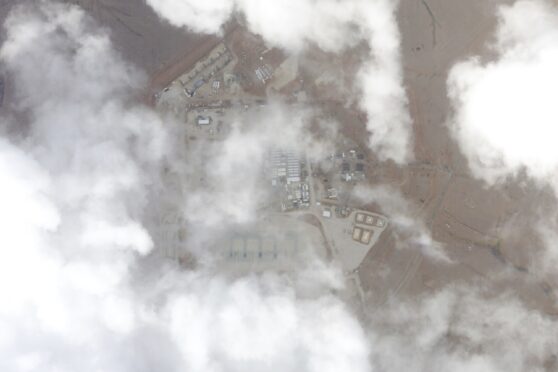An Iraqi militia official has hinted at a desire to de-escalate tensions in the Middle East following retaliatory strikes launched by the United States against dozens of sites in Iraq and Syria used by Iranian-backed militias and the Iranian Revolutionary Guard.
Hussein al-Mosawi, spokesperson for Harakat al-Nujaba, one of the main Iranian-backed militias in Iraq, in an interview with The Associated Press in Baghdad condemned the US strikes, saying Washington “must understand that every action elicits a reaction”.
But he then struck a more conciliatory tone, saying that “we do not wish to escalate or widen regional tensions”.
Al-Mosawi said the targeted sites in Iraq were mainly “devoid of fighters and military personnel at the time of the attack”.
CENTCOM Statement on U.S. Strikes in Iraq and Syria
At 4:00 p.m. (EST) Feb. 02, U.S. Central Command (CENTCOM) forces conducted airstrikes in Iraq and Syria against Iran’s Islamic Revolutionary Guards Corps (IRGC) Quds Force and affiliated militia groups. U.S. military forces… pic.twitter.com/HeLMFDx9zY
— U.S. Central Command (@CENTCOM) February 2, 2024
Syrian state media reported that there were casualties from the strikes but did not give a number.
Rami Abdurrahman, who heads the Britain-based Syrian Observatory for Human Rights, said that 23 people, all rank-and-file fighters, were killed.
Iraqi government spokesperson Bassim al-Awadi said in a statement on Saturday that the strikes in Iraq near the Syrian border killed 16, including civilians, and there was “significant damage” to homes and private properties.
A US official said on Saturday that an initial battle damage assessment showed the US had struck each of its planned targets in addition to a few “dynamic targets” that popped up as the mission unfolded, including a surface-to-air missile site and drone launch sites.
The official did not yet have a casualty assessment.
Iraq’s Foreign Ministry announced on Saturday it would summon the US embassy’s charge d’affaires – the ambassador being outside of the country – to deliver a formal protest over US strikes on “Iraqi military and civilian sites”.
The US said on Friday it had informed Iraq of the impending strikes before they started.
The air assault was the opening salvo of US retaliation for a drone strike that killed three US troops in Jordan last weekend.

The US has blamed that on the Islamic Resistance in Iraq, a coalition of Iranian-backed militias.
Iran, meanwhile, has attempted to distance itself from the attack, saying that the militias act independently of its direction.
Mr al-Awadi condemned the strikes as a violation of Iraqi sovereignty, particularly since some of them targeted facilities of the Population Mobilisation Forces (PMF).
The PMF, a coalition of Iranian-backed militias, was officially brought under the umbrella of the Iraqi armed forces after it joined the fight against the so-called Islamic State (IS) in 2014, but in practice it continues to operate largely outside of state control.
The Popular Mobilisation Forces said in a statement on Saturday that one of the sites targeted was an official security headquarters of the group.
In addition to the 16 killed, it said 36 people had been wounded, “while the search is still ongoing for the bodies of a number of the missing”.
The Iraqi government has been in a delicate position since a group of Iranian-backed Iraqi militias calling itself Islamic Resistance in Iraq – many of whose members are also part of the PMF – began launching attacks on US bases in Iraq and Syria on October 18.
The group described the strikes as retaliation for Washington’s support for Israel in the war in Gaza.
USCENTCOM Destroys Six Anti-Ship Cruise Missiles in Yemen
On Feb. 3, at approximately 7:20 p.m. (Sanaa time), U.S. Central Command forces conducted strikes in self-defense against six Houthi anti-ship cruise missiles prepared to launch against ships in the Red Sea. U.S. forces… pic.twitter.com/W9BVxiYedU
— U.S. Central Command (@CENTCOM) February 3, 2024
Behind the scenes, Iraqi officials have attempted to rein in the militias, while also condemning US retaliatory strikes as a violation of Iraqi sovereignty and calling for an exit of the 2,500 US troops who are in the country as part of an international coalition to fight IS.
Last month, Iraqi and US military officials launched formal talks to wind down the coalition’s presence, a process that is likely to take years.
One of the main Iran-backed militias, Kataib Hezbollah, said it was suspending attacks on American troops following Sunday’s strike that killed the US troops in Jordan, to avoid “embarrassing” the Iraqi government.
Meanwhile on Saturday, the US military’s Central Command acknowledged it had had a series of skirmishes in the Red Sea and the Gulf of Aden with Yemen’s Houthi rebels.
On Friday, the USS Carney shot down a drone over the Gulf of Aden and there were no injuries or damage.
The US also conducted air strikes on four Houthi drones preparing to launch that it said “presented an imminent threat to merchant vessels and the US Navy ships in the region”.
On Saturday, Central Command said it struck six additional anti-ship cruise missiles that it said were prepared to launch and presented an imminent threat.
Overnight, F/A-18 fighter jets from the USS Dwight D Eisenhower aircraft carrier, along with the USS Laboon, shot down seven drones in the Red Sea.
